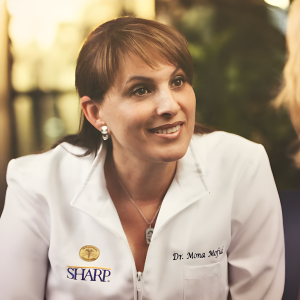Unveiling Sunburn Risks: Dr. Mona Mofid Explores UV Radiation, Cloudy Day Myths, and Sun Protection Essentials
— Dr. Mona Mofid
SAN DIEGO, CA, USA, January 24, 2024 /EINPresswire.com/ — In the world of skin protection and its intricate dance with cloudy skies, there lies a tapestry of complexity that is often overlooked. The conventional assumption that overcast weather provides a shield against sunburn is a myth that obscures the reality of ultraviolet (UV) radiation’s persistence. We asked Dr. Mona Mofid about topics such as the science behind sunburns, the reasons why UV exposure happens even during cloudy days, and the importance of having a disciplined sun protection routine.
Dr. Mona Mofid has decades of experience in the field of dermatology at the highest level, serving in positions such as medical director of The American Melanoma Foundation and clinical director of the Johns Hopkins Department of Dermatology. She holds the distinction of being the youngest-ever president of the Maryland Dermatological Society. Dr. Mona Mofid currently operates a private practice under the auspices of the Sharp Community Medical Group.
Here’s what she had to say about sunburns.
How do you get a sunburn even when it’s gloomy outside?
It’s a common misconception that an overcast sky naturally wards off the risks of UV-related skin damage. Yet, this basic idea barely even starts to uncover the complexities of the subject. The sun sends out a range of UV rays, including UVA, UVB, and UVC rays, each with its own distinct wavelengths and impacts on the skin.
While clouds possess the capability to block some UV rays, their protective capacity falls short of complete coverage. The sun’s rays can pass through cloud layers to differing extents, which can expose people to a large dose of UV radiation, even on days when the sky is covered with clouds. This deceptive scenario gives people a false sense of security, causing people to underestimate the important role that sun protection plays.
How does this happen?
To understand the meaning of ‘UV burn,’ we have to look beyond the superficial discomfort that is the sunburn. At its core, a sunburn is a radiation burn, a result of excessive exposure to UV radiation. Ultraviolet (UV) light comes in different forms, and UVA and UVB rays are the ones we’re concerned about. They reach us from the sun at various levels, depending on things like the angle of the sun and how thick the Earth’s ozone layer is.
Contrary to popular belief, sunburn isn’t solely a product of direct sunlight. Consider scenarios such as skiing at high altitudes or spending time near reflective surfaces like water bodies. In such instances, individuals are exposed to high levels of UV because of the sun’s reflective interaction with snow or water, which results in unforeseen and severe ‘UV burns.’
What are the effects of sunburns on the human body?
UV radiation, beyond impacting beach plans, is a major contributor to skin cancer and premature aging. With one in five Americans facing a lifetime skin cancer risk, and one succumbing every hour, protecting against UV rays is crucial. Exposure accelerates photoaging, causing wrinkles and reduced skin elasticity. Neglecting sunscreen not only risks sunburn and cancer but also speeds up skin aging.
How one can protect their skin from sunburns:
With the multitude of hazards tied to UV exposure, it’s imperative to establish robust sun protection strategies. These actions are indispensable for safeguarding the well-being of your skin and mitigating the potential for enduring repercussions.
Regardless of changes in weather, applying broad-spectrum sunscreen boasting an SPF of at least 30 is essential. Broad-spectrum sunscreens have your back against both UVA and UVB rays, offering a shield against harmful UV radiation even when the clouds roll in.
Putting on protective gear like long-sleeved outfits, hats with wide brims, and sunglasses designed to fend off UV rays provides substantial defense against UV exposure. Opt for darker, tightly woven fabrics to create a formidable barrier against the sun’s rays.
When walking outdoors, always be aware of shady areas in your area, where you can take cover from the sun. Trees, umbrellas, and awnings deliver natural barriers against direct sunlight and the UV radiation it carries.
Tanning beds emit concentrated UV radiation, significantly more damaging to the skin than natural sunlight. Completely avoiding tanning beds is an important step in safeguarding one’s skin health.
How does one relieve sunburn pain?
In the unfortunate scenario where you get a sunburn, there are several things you can do to alleviate discomfort and speed up the healing process. The application of cool, damp compresses or indulging in cool baths can give you relief from the inflammatory aftermath of a sunburn. Also, sunburn prompts dehydration. Increasing your water intake aids in replenishing the body’s fluids and accelerates the skin’s recuperation process.
Employing moisturizers enriched with aloe vera can provide relief to your skin, addressing intense dryness and the less-than-pleasant shedding often associated with sunburn. In case there are no contraindications, consider giving over-the-counter pain relievers such as ibuprofen a shot. These options can assist in alleviating both the discomfort and inflammation stemming from sunburn.
Harnessing Nature’s Panacea: Aloe Vera and Tepezcohuite
Aloe vera, a plant renowned for its potent soothing properties, has stood the test of time as a remedy for burns and skin irritations. Its gel serves as a natural balm for sunburned skin. Simultaneously, Tepezcohuite, derived from the Mimosa tenuiflora tree, has garnered attention for its medicinal attributes. This ingredient’s endorsement by celebrities like Salma Hayek has increased its popularity. Today, it’s known for its anti-aging attributes and its ability to foster skin healing.
In conclusion, to keep your skin safe, Dr. Mofid says that “it’s important to focus on sun protection every day. Make sure you apply sunscreen, opt for protective attire like hats and long sleeves, and actively seek out shaded areas when you’re outdoors. These steps are more than just avoiding sunburn; they’re a strategic defense mechanism against the potential risk of skin cancer and a method to maintain the youthful and vibrant appearance of your skin.”
Dr. Mona Mofid
Dr. Mona Mofid
+1 858-736-7815
email us here
Visit us on social media:
LinkedIn
![]()
Originally published at https://www.einpresswire.com/article/676559108/dr-mona-mofid-warns-about-sunburn-risks
The post Dr. Mona Mofid Warns About Sunburn Risks first appeared on Beauty Ring Magazine.
Beauty - Beauty Ring Magazine originally published at Beauty - Beauty Ring Magazine




